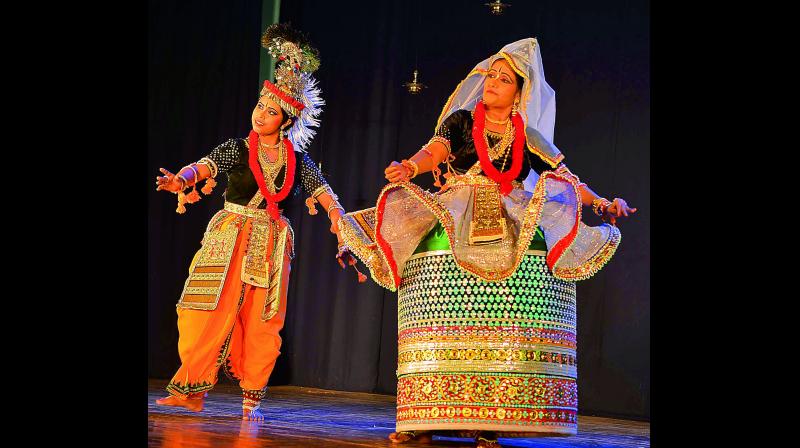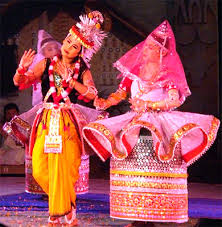- Home
- Culture of India
- Indian Dances
- Manipuri Dance
Manipuri dance
Manipuri dance is one of the major classical dance forms that originated from Manipur state of India. The dance is famous for its graceful movements and intricate Footworks. The dancers wear heavy costumes and jewellery. This dance form is deep rooted in the culture and traditions of Manipur. The dance is in the form of a dance drama based on Raslila (the love between Radha Lord Krishna). The main theme of this dance is Vaishanivism. Other themes include Shaktism, Shaivism and on the sylvan deities called Umang Lai during the Manipuri festival ‘Lai Haroba’. Among all these Raslila is the most prominent dance form. The Raas style of Manipuri dance is performed to depict the love story of Lord Krishna and the Gopis
These dances are a medium for worshipping and also for social gathering for the people. Lai Haroba is a dance festival that is associated with Meitie People (majority of ethnic people in Manipur) to please the deities with Lord Natraja postures.
Manipuri dance is a group dance with light sensual movements from women. The dance is very gracefully done with light lyrical music. Chali is the basic dance movement of Manipuri dance. The dance is performed in three forms: Tal Rasak, Danda Raska and Mandal Rasak.
This dance is performed three times a year. During spring season from March to April, then autumn from August –November and during Holi festival. All the three times it is performed on a full moon night. The main theme of the dance is the love between Radha and Lord Krishna with accompanying Gopikas namely Lalitha, Vishakha, Chitra, Sudevi, Rangadevi and Indurekha. The longest and the lengthiest play focus on Lord Krishna and Radha.
History and sequences of Manipuri dance
The dance has its roots from Natya Shastra, an ancient text on performing arts. It was written by Bharata Muni. The text consists of 6000 verses and 36 chapters.
The major reliable source available about the Manipuri Dance is from the early 18th century. Before that there were only oral tradition, archaeological discoveries about the Manipur dance form. According to the Meitei language text Bamon Khunthok discusses that Vaishnavism practices were adopted by the King of Manipur in the 15th century. Many changes did take place around 1700. In 1704, Pitambar Charaiongba who was the Meitei King ordered Vaishnavism as the state religion. Later in 1717 another king Meitei King Gareeb Niwaz, gave importance to Vaishnavism singing, dancing to be centered around Lord Krihna.
During the medieval period Maharaja Bhajyachandra of Manipur adopted Lord Krishna based songs to reform Manipuri dance. It is called Gaudiya Vaishnavism. He codified the Manipuri dancing pattern that helped in the revival of the dance. Among the five Ras lila three were composed by him Maha Ras, Basanta Ras and Kunja Ras. He also designed costumes for the revival. The costume included a mirror studded stiff skirt called Kumil. The dancer playing Lord Krishna character expresses emotions through different body language, and postures while the gopikas expresses the feelings of dejection or even sometimes happiness through different dance posture.
Further in the 19th century, Maharaja Gambhir Singh and Maharaja Chandra Kirti Singh composed ‘Nitya Ras’. The former is given the credit for composing ‘Goshtha Vrindaban Pareng’ and ‘ Goshtha Bhangi Pareng’ and the latter composed ‘Vrindaban Bhangi Parengi’ and ‘Khrumba Bhangi Pareng’ along with 64 Pung choloms which are performed as a prelude to ‘Ras Lila’.
During the British Period many of the Indian classical dance forms had seen a substantial decline and discouragement. Manipur was annexed by the British in 1891 which led to the decline of the Manipuri dance. The dance was ridiculed and was given the same treatment as with the other dance forms. With great difficulty, Manipuri dancers survived in temples like the Govindji temple in Imphal. The Christian missionaries had started the anti dance movement in 1892 which further made the decline of all dance forms. Finally the dance form was revived by the Indian Independence movement activists and scholars. In 1926 Guru Nabha joined the faculty at SHantiniketan to teach Raas Lila.
Repertoire
Repertoire:
The basic dance movement in the Manipuri dance is called the Chali or Chari. The repertoire and the play of the dance revolves around different seasons. Manipuri dance is usually performed three times in a year on full moon nights in autumn (August- November) and again one time in spring season(March- April). Basanta Ras is performed during Spring season in Holi, the other dance forms are performed post-harvest festivals like Diwali and other festivals.
The basic theme centers around the love of Radha and Krishna in the presence of Gopis named Lalita, Indurekha, Vishaka, Chitra, Tungavidya, Champaklata, Rangadevi and Sudevi. One of the composition and dance sequences would be dedicated to each of the Gopis and the longest play is dedicated to Radha and Krishna. The dancers show an excellent movement of hand gestures, body language and body expressions. The Gopis expresses the feelings of happiness, sadness and longing. In some forms of plays, the Manipuri dancers are more energetic, acrobatic and also wear costumes according to the dance theme
Costume of the dance

Manipuri dance has wonderful costumes, especially of women. The women dancers are dressed like a bride known as the Potloi costume. Kumil is the embroidered long skirt in the shape of a barrel with stiffened bottom along with Velvet blouse. Kumil is designed in the upper with flower shape and tied at three different places on the waist called as Pasuan. It opens like a flower. Above the Pasuan a rectangular belt knwn as Khangoi is worn by the female dancers along with Thabret (a girdle around the waist).
A velvet blouse or choli embellish the upper part of the body. The blouse is embellished with zari embroidery. Unlike other classical dances, Manipuri dancers do not wear ghungroo instead they wear a musical anklet made of leather straps. The dancers adorn their face, hand and neck with jewellery which goes well with the costume. Usually the female dancers cover their face with a light dupatta.
The male dancers wear dhoti pleated and tied to the waist along with peacock feathers to resemble lord Krishna. Some male dancers who perform in Pung Cholom wear white dhoti to the lower part of the body and white turban on the head. The drums straps on the right shoulders with a shawl to the left shoulders. Both male and female cover their heads. Females wear a thin transparent veil called Meikhumbi along with a cap covering the head called a koktombi. Males wear golden headdresses called Leittreng.
Musical Instruments
The musical instruments include Pung (a barrel drum), flute, Violin. The drummers are male singers and the lyrics of the songs are usually in the language of Sanskrit, Mithali and Brij Bhasha and the poetry includes Jayadeva, Vidyapati, Chandidas and Govindas.
Some famous Manipuri dancers include Guru Bipin Singha, Charu Mathur and many more.
Update on coronavirus in India
Affiliate Disclosure:
If you make any purchase via a link on this site, I may receive a small commission with no added cost to you.



